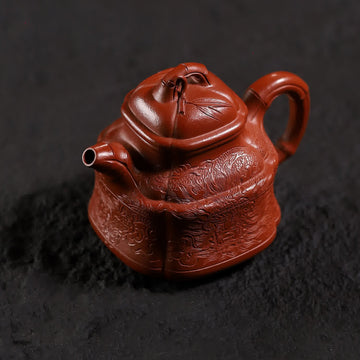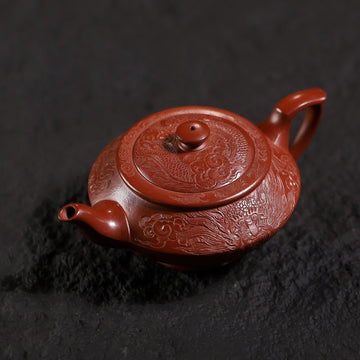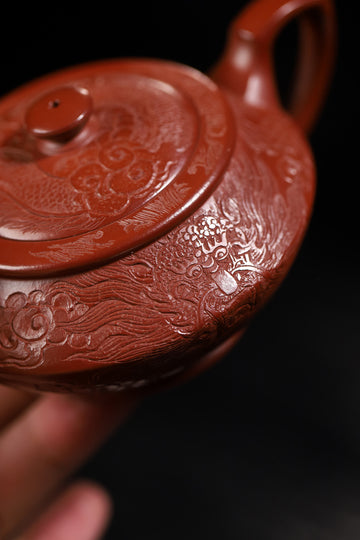Bamboo shaped Dragon Pattern Carving Fully Handmade Zhu Ni 'Bamboo Ding' Yixing Teapot
-
Estimated Delivery:Oct 30 - Nov 03
-
Free Shipping & Returns: On all orders

Bamboo shaped Dragon Pattern Carving Fully Handmade Zhu Ni 'Bamboo Ding' Yixing Teapot
Bamboo shaped Dragon Pattern Carving Fully Handmade Zhu Ni 'Bamboo Ding' Yixing Teapot
1. Material & Craftsmanship
Crafted from authentic Yixing Zhu Ni (Vermilion Clay), this teapot is entirely handmade. The clay is fine and smooth, exhibiting a pure reddish hue. A master artisan has employed exquisite carving techniques to engrave dragon patterns throughout the body, with detailed scales and surrounding clouds, showcasing perfect integration of traditional craftsmanship and royal motifs.

2. Design & Aesthetics
The teapot features the classic Bamboo Ding shape with a square-round body and clean lines. The bamboo-joint spout ensures a powerful pour, while the bamboo-shaped handle offers a comfortable grip. The bamboo-joint knob complements the overall design. The body is adorned with majestic dragon patterns, exuding imperial grandeur.

3. Symbolism & Meaning
The Dragon symbolizes supreme power, nobility, and auspiciousness in ancient Chinese culture. The Bamboo represents integrity, resilience and elegance. This piece blends imperial heritage with scholarly spirit, making it both a functional vessel and a carrier of Chinese cultural significance.
4. Brewing Experience
The high-quality Zhu Ni clay offers excellent porosity, making it ideal for brewing Pu'erh and Oolong teas. Its unique structure enhances the tea's aroma, resulting in a liquor that is mellow, sweet, and smooth. The spout design ensures a clean pour with precise water control.
5. Occasion & Value
Perfect for formal tea ceremonies or as a prestige gift, this teapot elevates any setting with its majestic presence. It embodies significant practical, artistic, and collector's value, serving as an heirloom piece that represents the pinnacle of Yixing craftsmanship.
Yixing Teapot Crafting Process
Seven steps of traditional craftsmanship passed down for centuries

Material Selection
Selecting the finest purple clay from Huanglong Mountain. Ore undergoes natural weathering and manual screening to ensure high purity and plasticity.
- Ore depth ≥5 meters
- 3-stage screening
- 72 hours weathering
- Clay purity >98%

Clay Refining
Traditional stone grinding techniques transform raw clay into workable material. The process ensures optimal plasticity for shaping.
- 12 hours grinding
- Manual pounding
- 48 hours sedimentation
- Precise moisture control

Hand Shaping
Artisans use paddle forming methods to create the teapot body. Continuous work ensures uniform thickness and smooth lines.
- Precise paddlings
- Thickness ≤0.5mm
- Unique fingerprint
- Spout/handle alignment

Intricate Carving
Master craftsmen carve patterns into the teapot surface. Each stroke reflects artistic vision and technical skill.
- Hand-carved details
- Traditional motifs
- Uniform 0.3mm depth
- Custom designs

Natural Drying
Teapots dry in controlled environments to prevent warping or cracking. Temperature and humidity are precisely maintained.
- 25±2℃ temperature
- 60±5% humidity
- 48-hour period
- Regular rotation

Traditional Firing
Traditional kilns fire teapots at 1180°C±10°C for 12 hours. Pine wood firing imparts unique mineral effects.
- Precise temperature
- 12-hour duration
- 48-hour cooling
- Pine wood effects

Fine Polishing
Artisans hand-polish teapots using natural materials. The process enhances luster and creates a protective layer.
- 3-stage process
- Natural beeswax
- Gloss inspection
- Quality control
Teapot Seasoning and Maintenance

1. Seasoning Method
1. Cleaning
Remove any dust or impurities from inside and outside the teapot and its components. Rinse the teapot thoroughly with hot water to warm it up.
2. Initial Brewing
Brew your preferred tea in the pot and pour the tea liquor over the exterior. When the temperature is high, the subtle pores of the teapot expand slightly, allowing moisture to appear on the surface. Gently wipe the body with a tea maintenance cloth while it is still warm. Repeat this entire process at least three times. Note: The tea brewed during this step is not suitable for drinking.
3. Drying
After several rounds of brewing, the “fire energy” (raw kiln feel) of the teapot will be largely reduced. Rinse the pot with clean water and let it air dry completely. It is then ready for daily use.
Tip:
If a strong chemical odor is detected after boiling or if the color of the pot fades, it may indicate a chemically dyed teapot. This method can help identify authentic Zisha clay.
2. Maintenance Principles
-
Before brewing, moisten the outside of the pot with warm water before adding water inside—a practice known as “rinsing the pot.”
-
After use, wipe the exterior with a soft cloth to keep it dry. Avoid leaving tea liquid inside to prevent residue buildup, which may affect the pot’s appearance.
-
Allow the teapot to “rest” for 3–5 days after a period of use, ensuring it dries thoroughly.
-
Keep the pot away from oily or dusty environments to maintain the porous structure of the clay.
-
Follow the “one teapot for one type of tea” rule to prevent cross-flavoring.
-
Never use detergents or chemical cleaners, as they can damage the natural luster of the teapot.
Shipping cost is based on weight. Just add products to your cart and use the Shipping Calculator to see the shipping price.
We want you to be 100% satisfied with your purchase. Items can be returned or exchanged within 30 days of delivery.
Recently Viewed Products

































